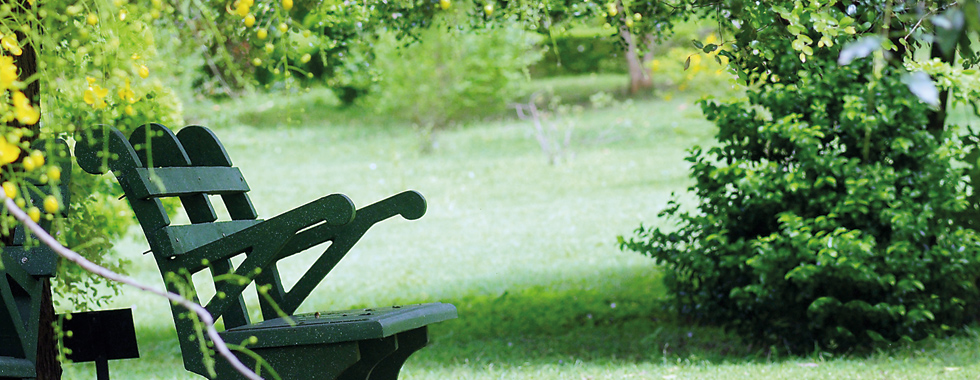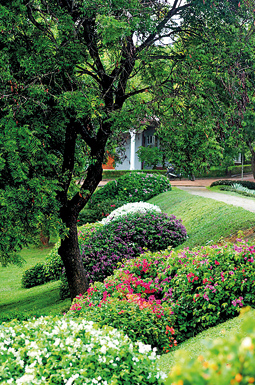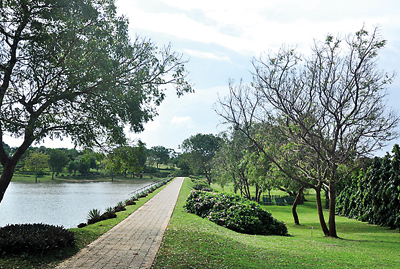How does your garden grow?
Developing a new Botanical Garden is no easy task as Dr. Siril Wijesundara, Director General of the Department of National Botanic Gardens, the man behind the Mirijjawila Dry Zone Botanic Gardens, Hambantota well knows. “Some people could not believe that it is possible to have lush greenery in the Dry Zone, let alone a Botanical Garden,” he says, happy to have taken on the challenge.

Greening Mirijjawila: Views of lush foliage and serene landscape
The Mirijjawila Botanical Gardens will be opened on November 14 to coincide with the Commonwealth Heads of Government Meeting (CHOGM) being held in Sri Lanka this week.
Recalling Sri Lanka’s history Dr. Wijesundara reminds us that our Great Kings had built beautiful gardens in Anuradhapura and Tissamaharama. Sigiriya had a landscaped garden. “This shows that there were clever landscape artists in ancient Sri Lanka. Now we see only the relics of hard landscape.” he laments. Gardening is in our blood, he feels so, why not take a page from history and create a 21st Century garden in the dry zone.”
The British established Botanical Gardens in Sri Lanka mainly to introduce economic crops. The Henarathgoda Botanical Gardens in Gampaha was established to conduct trials to introduce Rubber to Sri Lanka. Rubber plants were first brought from the Amazon by the British to the Royal Botanic Gardens, Kew in England, then sent to Royal Botanic Gardens, Peradeniya and then to the newly established Henarathgoda Botanical Gardens in 1876. Rubber seeds produced at Henarathgoda were introduced to Singapore and from there to Malaysia.

We have three botanical gardens at present – Peradeniya (established in 1821), Hakgala (established in 1861) and Gampaha (1876). Now, after more than 130 years comes the Mirijjawila Botanical Gardens, the fourth in the country. “What is unique about the Mirijjawila Botanical Gardens is that there has been no foreign collaboration and 100% of the finances are from the Government Treasury, with the expertise from Sri Lankan scientists and professionals,” says Dr. Wijesundara with pride. “It is a home-grown garden!”
“The idea to develop a botanical garden in the Dry Zone had been there for some time. The first step was to find suitable land and then the required water.” Many places were visited and finally in 2004, a site, which belonged to the Mahaweli Authority in Mirijjawila was found to be suitable due to the large extent of land and most important a wila (lake) nearby. The water from the Baragama wila flows direct to the sea without being used for any agricultural purpose. This water could be used for the gardens. It was also an ideal place to preserve the fauna and flora abundant in the region. “Yes, there were peacocks, deer, water monitors, birds and butterflies. At present there are flocks of migrant birds in the area,” said Dr. Wijesundara.
But after the 2004 tusnami, plans were shelved. In 2005 the Botanical Gardens Division was separated from the Department of Agriculture to form a new Department, namely the Department of National Botanical Gardens. Secretary to the new Ministry of Promotion of Botanical and Zoological Gardens S. Liyanagama, visited Hambantota with Dr. Wijesundara to scout for a suitable site, along with the Government Agent, Hambantota.
Inspecting the site again, they found barriers due to the newly built tsunami houses and on the southern side, land being reserved for an Oil Refinery. However, the Department was able to acquire the present site which is 300 acres in extent from the Mahaweli Authority in 2006. Planting began in 2008. The footpaths and terrain of the land were preserved as much as possible without disturbing the natural landscape. A section was developed for floriculture as a sustainable community development project.
Dr. Wijesundara says he had the full freedom to plan and design this project and is grateful to the ministers and secretaries who supported him. It involved a joint effort with several state institutions -the National Water Supply and Drainage Board helped in the development of a water tower with a powerful pump house and a capacity of 225 cubic metres, which is the largest water scheme constructed by the Board. The daily capacity of 1000 cubic metres is obtained from the nearby Baragama wila. The State Engineering Corporation, the Road Development Authority, the Buildings Department and the Central Electricity Board also provided their expertise.

Crediting his staff for the landscaping, planning , Dr. Wijesundara says his work was made easy by the contribution made by the site Officer-in- charge Sumith Ekanayake, floriculturist, Madhuri Peiris while the landscape supervisory work was done by A.B. Meddegoda, Sanath Udaya Kumara, Dinesh Fernando, Asela Leelarathna, Jayawardena, and Dulan.
With the country’s rich agro-biodiversity experiencing many threats due to unplanned land use, pollution, fragmentation and alteration of farming systems, Dr. Wijesundera’s view is that the benefits of conserving the dry zone habitat and its distinctive vegetation are many. This garden can play a role in ex-situ conservation of some of the more important components of agro-biodiversity found in the dry zone, he believes.
Botanical Gardens are not just “flower gardens” or “malwattas”. They are scientific institutions holding a diverse documented plant collection (aesthetically arranged), maintained by scientists for conservation, research and education and of course display.
“We have a rich biodiversity (probably the highest biodiversity per unit area in this part of the world) and we need to conserve plants ex-situ (outside the native habitat), as the natural habitats are endangered. As our country is very diverse floristically, we need more gardens to conserve plants in different climatic zones. For example we cannot conserve a plant from Hambantota in a garden in Nuwara Eliya and vice versa. “Mirijjawila was selected as it is the driest area in the country with 650 mm. or less annual rainfall. Mannar gets 100 mm. more than that. Mirijjawila will conserve dry and arid zone plants. All our existing botanical gardens are in the Wet Zone.”
With education and training programmes, the new gardens could be a resource for educational institutions at all levels.
A special area is preserved for indigenous herbs. Floriculture is also highlighted and local residents have already been trained and are encouraged to develop their home gardens for export of cut flowers and foliage as a self-employment project.
A wooded area is planned with trees such as Burutha, Domba, Ehela, Gammalu, Halmilla, Helamba, Ingini, Kaluwara, Kohomba, Kon, Kotamba, Kumbuk Madadita and many more.
Popular cut flowers such as anthuriums, gerberas and orchids are already thriving at Mirijjawela. “I never thought I would live to see the Vandas and Cattleyas bloom in such a riot of colour,” Dr. Wijesundara says
He visualises the ‘patch of green’ like Central Park in New York in a few years time with houses surrounding it! An ‘escape’ from the concrete jungle! An environment for recreation and relaxation.



